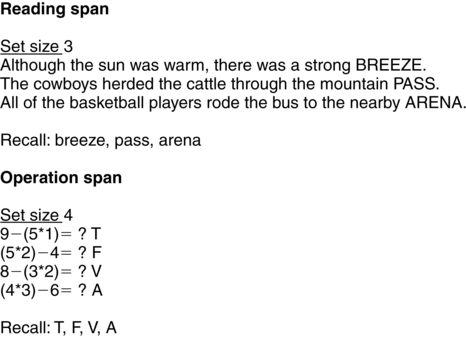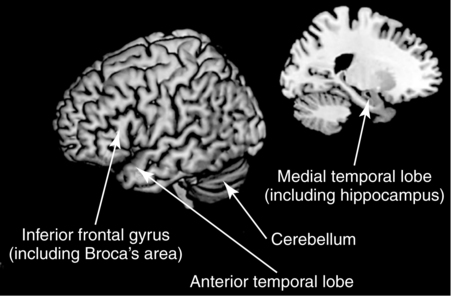CHAPTER 9 Randi Martin and L. Robert Slevc Understanding and producing language are complicated cognitive tasks that draw on several different memory systems. To link information from different parts of a sentence, some type of short-term memory (STM) or working memory (WM) system is needed. To understand word meanings and analyze the structure of a sentence, it is necessary to draw on long-term memory (LTM) representations for word meanings and the allowable grammatical sequences in the language. In order to make sense of discourse and draw appropriate inferences it is necessary to draw on memory of events and facts and episodic memory about when and where a conversation took place are needed. Damage to these STM and LTM systems thus impacts language processing, and the nature of these impacts can inform our understanding of language deficits. In this chapter, we will consider first the consequences for language processing of damage to STM, or WM, and then the consequences of damage to LTM systems. Figure 9-1 provides a diagram of the various types of memory systems considered in this chapter. As discussed in Chapter 5, current theorists distinguish between passive STM systems and a WM system (Engle, Tuholski, Laughlin, & Conway, 1999). For instance, a passive storage system is assumed to be involved in standard span tasks that involve repeating back a list of digits or words. A WM system, in contrast, is thought to reflect a capacity for both maintaining information and operating on that information—thus, encompassing both storage and processing (Daneman & Carpenter, 1980). More complex tasks, like reading span or operation span (Figure 9-2), have been used to tap WM capacity. In the reading span task, individuals read aloud sentences and attempt to remember the last word of each sentence, recalling these last words at the end of a set of sentences (which might vary from 3 to 7 sentences in length). In the similar operation span task, individuals carry out an arithmetic problem on each trial and then are asked to remember a letter or word following the problem (Turner & Engle, 1989). Again, at the end of a series of arithmetic problems, they attempt to recall the series of letters. In both cases, information has to be maintained while other processing is being carried out. Aphasic patients are almost universally impaired on simple span tasks involving word list recall (Martin & Ayala, 2004). While neurally healthy adults may have a STM span of about 7 digits and 5 words, aphasic patients typically have spans of 1 to 3 items. A large body of research has examined the causes of these STM deficits and their consequences for aphasic patients’ language comprehension and production. In some theoretical positions, the passive storage involved in word span tasks is assumed to be a buffer that maintains phonological representations (e.g., Baddeley, 1986). In other approaches that take a more language-based approach to STM, both phonological and semantic information are thought to support word list retention. R. Martin and colleagues (e.g., Martin, Shelton & Yaffee, 1994) and N. Martin and colleagues (e.g., Martin & Saffran, 1997) have provided patient data supporting the latter view. For instance, Martin et al. (1994) and Martin and He (2004) have shown that some patients show a deficit specifically in maintaining phonological information and others show a deficit specifically in maintaining semantic information. Those with a phonological STM deficit fail to show the standard effects of phonological variables on span performance (e.g., failing to show an effect of phonological similarity of the words in the list) but do show effects related to semantic variables (e.g., performing better with word lists than lists made up of nonwords such as “pem, dat, tur”). Patients with a semantic STM deficit show the reverse pattern, showing effects of phonological variables, but failing to show effects of semantic variables (for instance, performing at the same level on word and nonword lists). Two tasks that have been shown to discriminate the patients with semantic and phonological STM deficits are the category and rhyme probe tasks (Figure 9-3). In both tasks, patients hear a list of words followed by a probe word. In the category probe task, subjects must judge if the probe word is in the same category as any of the list words. In the rhyme probe task, subjects judge whether the probe word rhymes with any of the list words. Patients with a phonological STM deficit perform better on the category than the rhyme probe task, whereas the patients with a semantic STM deficit perform better on the rhyme that the category probe task. (See also Barde, Schwartz, Chrysikou, & Thompson-Schill, 2010; Hoffman, Jefferies, Ehsan, et al., 2009; Wong & Law, 2008, for recent replications of these findings.) N. Martin and colleagues have presented other data showing different effects of semantic and phonological variables on recall of words which are correlated with patients’ semantic and phonological processing abilities. For instance, a composite measure of semantic processing is correlated with imageability effects on span, whereas a composite measure of phonological processing is correlated with frequency effects on span. Based on these dissociations, Martin, Lesch, and Bartha (1999) presented a model of verbal STM that includes separate capacities for retaining semantic and phonological information (Figure 9-4). On the left hand side of Figure 9-4 are the types of knowledge representations that one has about words. On the right are buffers used to maintain these different types of representations. In addition to separate buffers for semantic and phonological information, as shown in Figure 9-4, separate capacities are assumed for maintaining input and output phonological representations. Input representations are those derived from the perception of speech. Output representations are those used in speech production. Martin et al. (1999) and others (e.g., Allport, 1984; Shallice & Butterworth, 1977) have presented evidence showing that patients can have poor retention of spoken words on the input side but show normal patterns of speech production (implying preserved output phonological retention), whereas other patients can show normal retention of phonological representations during speech perception but have difficulty in maintaining phonological information used in production. A surprising finding coming out of studies carried out during the late 1980s and early 1990s was that a phonological STM deficit appeared to have few consequences for sentence comprehension, even for complex sentences with a large intervening distance between the words that needed to be linked together (e.g., Butterworth, Campbell, & Howard, 1986; Caplan & Waters, 1999; Martin et al., 1994; Martin & Romani, 1994). Martin and Romani (1994) and Martin and He (2004), however, reported that a semantic STM deficit (but not a phonological STM deficit) was related to deficits in comprehending certain sentence types. Specifically, in a task in which subjects had to indicate whether sentences were sensible or anomalous, the patients had difficulty making those judgments for sentences in which several adjectives came before a noun (e.g., “rusty old red wagon” versus “rusty old red swimsuit”) or several nouns came before a verb (e.g., “glasses, vases, and mirrors cracked” versus “rugs, vases, and mirrors cracked”). They did much better when the adjectives followed the noun (e.g., “the wagon was old, red, and rusty”) or the nouns followed the verb (e.g., “the movers cracked the mirrors, vases, and glasses”). These authors argued that in the “before” conditions, individuals had to maintain the meanings of the adjectives or nouns in an unintegrated fashion until the respective noun or verb was processed, thus overloading their restricted STM capacity. In contrast, in the “after” condition, each adjective could be integrated as a modifier of the noun as it was heard and each noun could be integrated as an object of the verb as it was heard. The assumption was that once these integrations had been made, the STM representation was no longer needed. Given the poor performance of the patients with semantic STM deficits and the good performance of the patient with a phonological STM deficit, these authors argued that the retention of semantic information, rather than phonological information, was critical for maintaining the words prior to integration. Martin and colleagues have reported evidence from aphasic patients suggesting that semantic STM capacity is critical for this advance planning in production. In one study, Martin and Freedman (2001) showed that patients with a semantic STM deficit had difficulty producing adjective-noun phrases (e.g., “long blonde hair”), tending to produce these utterances in piecemeal fashion (Figure 9-5). For example, for the target utterance of “small leaf”, patient AB produced, “It’s a leaf. It’s small.” These same patients did better when asked to produce the same information in a sentence frame (e.g., “The leaf is small”). A patient with a phonological STM deficit performed at a normal level for both utterance types. In a related study, Martin, Miller, and Vu (2004) showed that patients with a semantic STM deficit had difficulty producing sentences that began with a conjoined noun phrase (e.g., “the ball and the block moved”) compared to sentences that began with a single noun (e.g., “the ball moved”). A patient with a phonological STM deficit showed a latency difference between the two sentence types that was well within the range of controls. Martin and colleagues concluded that speakers plan at a phrasal level, attempting to plan all of the lexical-semantic representations for a phrase prior to beginning phonological retrieval for that phrase. The normal performance for the patient with a phonological STM deficit in the two studies might be attributed to the fact that there is very limited planning at the phonological level (which was within the capacity of the patient) or to a dissociation between input and output phonological retention (Martin et al., 1999). That is, there may be separate capacities for maintaining phonological representations involved in speech perception and those involved in speech production (Shallice & Butterworth, 1977; Romani, 1992). The patient studied by Martin and colleagues may have had a deficit on the input side but not on the output side (Martin et al., 1999). Although a phonological STM deficit appears to have few consequences for sentence comprehension and production, it does have consequences for the learning of novel phonological forms (i.e., the learning of new words or names) (Baddeley, Papagno, & Vallar, 1988; Freedman & Martin, 2001). Freedman and Martin (2001) showed contrasting patterns of learning impairments for patients with phonological and semantic STM deficits. Those with phonological STM deficits had greater difficulty learning foreign translations of English words than in learning new meanings for known words. Those with semantic STM deficits showed the reverse pattern, indicating that semantic STM was needed to transfer new semantic information to LTM. Thus, there was a code-specific relation between short-term retention and long-term learning. Although STM and WM are different theoretical concepts, performance on the tests used to tap the two is usually correlated to a moderate degree for healthy subjects, presumably because WM performance relies to some extent on storage in passive storage systems (e.g., in a phonological STM buffer) and because STM tests rely on processing to some extent (e.g., whatever strategies subjects might use to help remember a list of words) (Engle et al., 1999). Since aphasic patients are so impaired at simple span tasks, they are typically very impaired at WM tasks as well if only because of the contribution of passive storage to WM measures. Consequently, one may look to other patient groups such as those with dementia of the Alzheimer type (DAT patients) or with Parkinson’s disease, whose performance is better preserved on simple span tasks, to examine the effects of WM deficits on sentence processing. Caplan and Waters and colleagues (see Caplan & Waters, 1999, for an overview) carried out several studies examining the role of WM in sentence comprehension. They demonstrated that both DAT and Parkinson disease patients had preserved phonological retention and rehearsal but had very reduced WM capacities as measured by tasks like the reading span task (e.g., a WM span of less than one in the case of the DAT patients). For both patient groups, they showed that the effect of syntactic complexity was no greater than for controls. However, both groups showed an exaggerated effect of the number of propositions in the sentence. (See examples of variations in syntactic complexity and number of propositions in Table 9-1.) Caplan and Waters (1999) explained these findings on the grounds that different WM resources support interpretive versus postinterpretive aspects of sentence processing. By interpretive processing, they refer to “the processes of recognizing words and appreciating their meanings and syntactic features; constructing syntactic and prosodic representations; and assigning thematic roles, focus, and other aspects of propositional and discourse-level semantics . . . ” (p. 78). By postinterpretive processing, they refer to “remembering the content of a sentence, using the meaning of a sentence to plan action, reasoning on the basis of sentence meaning” and other related processes (p. 79). For interpretive aspects, they assume a dedicated WM system for language processing that is not tapped by standard span tasks (either simple or complex). For postinterpretive processing, general WM resources are drawn upon. Thus, in order to accommodate their findings, they have to assume that variations in syntactic complexity affected interpretive processes whereas variations in number of propositions affected postinterpretive processes. Table 9-1 Sentence Materials Varying on Syntactic Complexity and Number of Propositions From Caplan, D., Alpert, N., & Waters, G. (1998). Effects of syntactic structure and propositional number on patterns of regional cerebral blood flow. Journal of Cognitive Neuroscience, 10, 541–552. A number of studies in the literature on healthy individuals have demonstrated a relation between WM capacity and the ability to allocate attention to external stimuli and internal representations and to inhibit attention to interfering material. For instance, there is a negative correlation between WM capacity and the size of the standard Stroop effect (Kane & Engle, 2003), which reflects the degree of interference in naming the ink color of a written color word (e.g., saying “green” to the word “red” written in green ink). Attention allocation is thought to be one aspect of executive function (EF), which involves coordinating goal-directed behavior. A recent study by McCabe, Roediger, McDaniel, et al., (2010) found a very high correlation between factor scores for WM (derived from several measures of complex span) and EF (derived from several standard EF tasks such as the Wisconsin Card Sorting task). These findings suggest that deficits in WM might be related to deficits in aspects of EF. Hamilton and Martin (2005, 2007) presented evidence that an aphasic patient (ML) who showed a semantic STM deficit had difficulty inhibiting verbal information, but not nonverbal information. For instance, he showed a verbal Stroop effect that was many standard deviations outside the normal range but showed an effect within normal range on a spatial analogue to the Stroop effect. On a recognition probe task (that is, a task in which subjects decide if a probe word matches an item in a previous list), ML showed highly exaggerated interference effects if the probe matched an item in a previous list or was even phonologically or semantically related to a previous list item. Hamilton and Martin (2005) proposed that the patient had a specific difficulty in inhibiting irrelevant verbal representations. A study by Biegler, Crowther, and Martin (2008) showed that this patient and another with a semantic STM deficit had exaggerated difficulty in repeatedly naming items from the same semantic category. They suggested that this repeated naming from the same category led to an overactivation of all of the terms in the category. Difficulty in inhibiting the incorrect names led to increasingly longer naming latencies for same-category items relative to different category items. They hypothesized that the left inferior frontal gyrus (Figure 9-6), which was affected in these patients, is involved in verbal inhibition. A deficit in inhibition could cause difficulty in spontaneous speech, where one needs to inhibit what has already been talked about to produce the next words. Recently, Barde et al. (2010) have offered another interpretation of the interference effects demonstrated by ML in the recognition probe task described earlier (Hamilton & Martin, 2007). They suggest that the effects can be accounted for by reactivation of the prior list item by the rhyming or semantically related probe word and a rapid loss of the semantic or phonological features of the probe that makes it difficult for the patient to verify whether the item matches the probe or not. They present data from 20 aphasic patients with varying degrees of semantic and phonological STM deficits. Consistent with their hypothesis, they show that the degree of phonological interference is accounted for by the degree of phonological STM deficit and the degree of semantic interference is accounted for by the degree of semantic STM deficit. It is unclear how their hypothesis can account for ML’s difficulties on the Stroop task (or more recent data indicating an exaggerated picture-word interference effect; Biegler et al., 2008). However, it is possible that these are simply co-occurring deficits for ML and not causally related to the STM deficit. Only the investigation of a large number of patients on STM as well as single word tasks involving interference can address this issue. Recently, Hoffman, et al. (2009) proposed that EF deficits are the source of semantic impairments in aphasia (see further discussion later). That is, they argue that aphasic patients do not have a disruption of semantic knowledge per se but instead have a deficit in controlling access in a task-dependent fashion to appropriate aspects of semantic knowledge. These patients’ lesions in left frontal and/or parietal regions are thought to underlie their semantic control deficit as these regions have been implicated in executive functioning (Collette, Hogge, Salmon, & van der Linden, 2006). This control deficit contrasts with a deficit in semantic knowledge representation, which is observed in semantic dementia (Box 9-1). They further argue that patients with a semantic STM deficit are those who have the most mild semantic control deficits. Patients with more severe semantic control deficits demonstrate obvious difficulties on processing single words such as in picture naming or picture-word matching. For patients with mild control deficits, their difficulties in semantic processing appear only when they have to process word lists rather than single words. However, semantic difficulties with single words can be observed for even the mildly affected patients if they are put under some kind of pressure (i.e., time pressure or having to select words from strongly interfering words). As discussed earlier, a number of lines of evidence suggest that the left inferior frontal gyrus (LIFG; see Figure 9-6) is involved in inhibiting verbal representations. Thompson-Schill and colleagues have made a more general proposal, arguing that the LIFG is involved in selection, that is, in selecting target representations from competing ones (e.g., see Thompson-Schill, Bedny, & Goldberg, 2005, for an overview). This selection could be involved in choosing, for example, a synonym from a closely related word, judging the relatedness of word meanings on a particular dimension, or producing a name for a picture when several names might be appropriate. Thompson-Schill and Botvinick (2006) have suggested that this selection deficit arises from difficulty in biasing the cognitive system toward targeted information rather than in inhibiting nontarget information (see Botvinick, Braven, Barch, et al., 2001). This line of work has been extended to explain sentence comprehension deficits in patients with LIFG damage. In particular, Novick, Trueswell, and Thompson-Schill (2005) argued that the LIFG was part of a frontal system involved in detecting conflicting representations and in sentence processing initiated the reanalysis of a misinterpreted sentence. As Broca’s area is part of the LIFG, they suggested that sentence processing deficits in patients with damage to Broca’s area might be interpreted as due to a difficulty in reanalysis rather than to a syntactic deficit per se. Recently, Novick, Kan, Trueswell, and Thompson-Schill (2009) presented evidence that a patient with damage to the LIFG had great difficulty overcoming the tendency to interpret “on the mat” as the destination in the sentence “Put the frog on the mat in the box.” In comparison, patients with frontal damage but without LIFG damage performed in a normal fashion. They further showed that the patient with LIFG was impaired a number of nonsentence tasks involving the resolution of conflict whereas the non-LIFG patients were not. Reduced STM span, as often observed in aphasia, has few consequences for language comprehension and production if the span deficit reflects difficulty maintaining phonological information. In contrast, a deficit in maintaining semantic information causes difficulties for both comprehension and production. Phonological STM is important, however, for learning new phonological information; similarly, semantic STM is important for learning new semantic information. There is controversy whether semantic STM deficits reflect a rapid loss of semantic information or a deficit in various EFs (such as an inhibition deficit). Deficits in more complex WM appear to affect the ability to carry out what have been termed postinterpretive aspects of sentence processing rather than more on-line interpretive aspects (Caplan & Waters, 1999). The preceding discussion has focused on STM systems and their role in retrieving, maintaining, and manipulating representations of meanings, facts, and general world knowledge drawn from LTM. These representations are a part of long-term semantic memory, referring to memory of meanings, concepts, and general world knowledge that are unrelated to specific experiences, and are thus a crucial part of language processing. Deficits in semantic memory can occur as a result of a variety of neurological conditions, including semantic dementia, stroke, herpes simplex virus encephalitis (HSVE), and Alzheimer disease (see Box 9-1), and can have drastic consequences for language. Semantic dementia is a subtype of frontotemporal dementia (and a further subtype of primary progressive aphasia) that results from atrophy of the anterior temporal lobes (see Figure 9-6) bilaterally, though often the atrophy is greater in the left hemisphere (Mummery, Patterson, Price, et al., 2000). Patients suffering from semantic dementia show a progressive loss of both productive and receptive vocabulary, stemming from a loss of semantic knowledge (Hodges & Patterson, 2007; Snowden, Goulding, & Neary, 1989; Warrington, 1975). Semantic dementia patients typically first lose knowledge of fine-grained features of concepts while retaining knowledge of more common or typical features. Thus words tend to be replaced with more general terms (e.g., “animal” instead of “camel”) and less typical features are omitted when drawing (e.g., if asked to draw a camel, a semantic dementia patient would likely include a head, two ears, and four legs, but omit distinctive features such as the hump). This correspondence between word production and drawing suggests that the loss of semantic knowledge in semantic dementia is multimodal, as is further evidenced by a corresponding loss of knowledge of how to use objects in the later stages of the disease (Bier & Macoir, 2010; Hodges, Bozeat, Lambon Ralph, et al., 2000). Semantic dementia patients also typically develop symptoms of surface dyslexia, where irregularly spelled words (e.g., yacht) are read as if they were regular (Woollams, Lambon Ralph, Plaut, & Patterson, 2007) demonstrating the role of semantic memory in processing of exception words (i.e., words with irregular grapheme-to-phoneme correspondences). Semantic dementia has been particularly influential because the deficit seems to be limited to semantic memory. Despite their severe semantic memory impairment, semantic dementia patients seem to have preserved syntactic processing, phonology, calculation ability, and drawing skills (at least in the earlier stages; Ash, Moore, Antani, et al., 2006; Hodges et al., 1999). Semantic dementia contrasts with progressive nonfluent aphasia, another form of frontotemporal dementia, which shows essentially the opposite pattern: impaired syntactic and phonological production in the context of spared semantic knowledge (Grossman, 2010). Importantly, patients with semantic dementia also appear to have relatively preserved episodic memory (i.e., memory for events, though the semantic memory deficits can make this difficult to demonstrate; Hodges & Patterson, 2007). The amodal nature of the semantic memory deficit in semantic dementia suggests a relatively general role of the anterior temporal lobes in semantic memory. One recent proposal along these lines is that the anterior temporal lobes serve as a “hub” that integrates distributed modality-specific semantic information (Jefferies, Baker, Doran, & Lambon Ralph, 2007; Jefferies & Lambon Ralph, 2006; Lambon Ralph & Patterson, 2008; Patterson, Nestor, & Rogers, 2007; Rogers, Lambon Ralph, Garrard et al., 2004; see also Damasio, 1989). Some of the major motivations for this type of theory come from differences between patients with semantic dementia and stroke patients with semantic memory deficits.
Memory disorders and impaired language and communication
Memory disorders and impaired language and communication
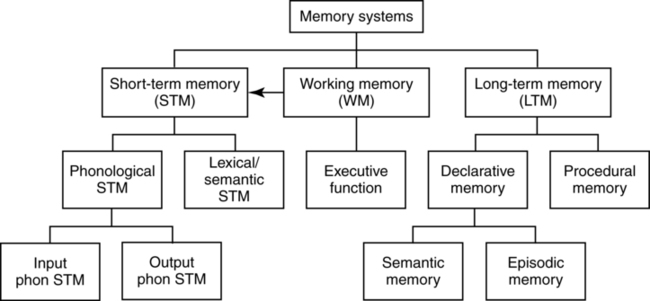
Disorders of short-term memory and working memory
Short-term memory deficits
Phonological versus semantic short-term memory deficits
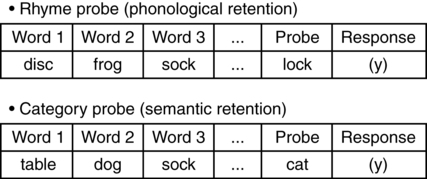

Effects of short-term memory deficits on comprehension
Effects of short-term memory deficits on production
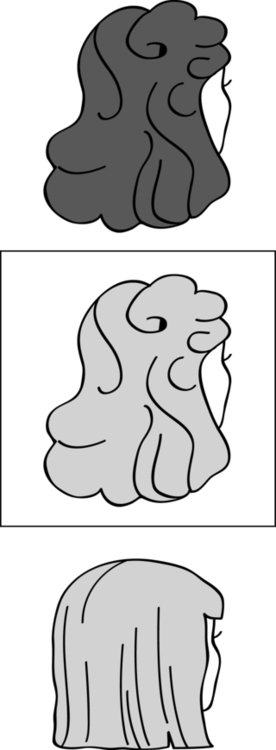
Effect of short-term memory deficits on learning
Working memory deficits
Interpretive versus postinterpretive aspects of sentence processing
Syntactically simple
The child spilled the juice that stained the rug.
Syntactically complex
The juice that the child spilled stained the rug.
One proposition
The magician performed the stunt and the joke.
Two propositions
The magician performed the stunt that included the joke.
Working memory and executive function
Semantic control
Selection deficits
Summary of short-term memory and working memory deficits and their role in language processing
Semantic memory deficits
Semantic dementia
![]()
Stay updated, free articles. Join our Telegram channel

Full access? Get Clinical Tree


Memory disorders and impaired language and communication

